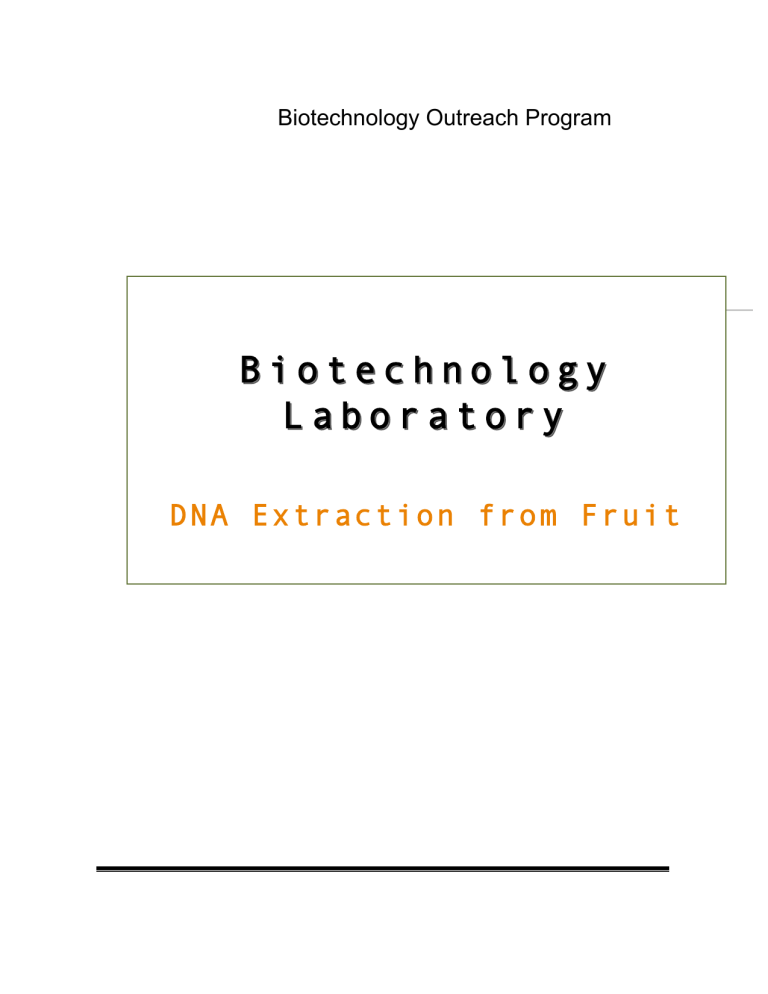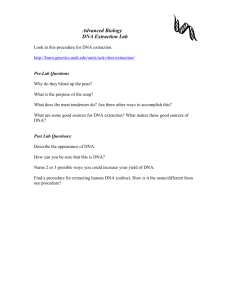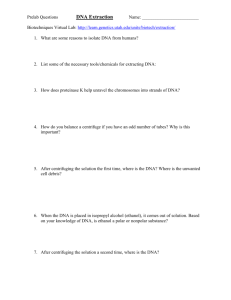Biotechnology Laboratory

Biotechnology Outreach Program
DNA Extraction from Fruit
DNA Extraction
Introduction
Students extract a visible mass of DNA from 4 different fruits and visually compare the amount of the DNA collected. Attached readings and activities will illustrate the structure and function of DNA.
This activity is designed to give students basic concepts that are vital for understanding agricultural biotechnology:
1. Understand DNA is in the cells of all living organisms including in the foods we eat.
2. Determine how each of the ingredients in the protocol help extract DNA.
3. DNA can be extracted from cells for scientific use.
4. Extract a visible mass of DNA from fruit tissue.
In this extraction activity we have the students compare the papaya from 4 different fruits. Students find this more interesting than using a single fruit and it allows the instructor to introduce more concepts. Questions that you may want to explore include:
Hawaii Standards
1. SC.BS.4.2 Describe different cell parts and their functions.
2. SC.BS.4.5 Describe the components and functions of a variety of macromolecules active in biological systems.
DNA Extraction from Fruit
Background
DNA (deoxyribonucleic acid) is located in cells of all living organisms. In its strands lies the blueprint for life. The DNA molecule directs the synthesis of every protein and contains all the genetic information that is passed on to new cells.
In complex eukaryotic cells such as those from plants, animals, fungi and protists, most of the DNA is located in the cell nucleus (chloroplasts, mitochondria, and ribosomes also carry some DNA). By contrast, in simpler cells called prokaryotes, including the eubacteria and archaea, DNA is not separated from the cytoplasm by a nuclear envelope.
Although DNA is an incredibly small molecule, in large quantities, it can be seen. In this activity, you will extract DNA from a papaya.
One of the reasons fruits work so well is that they are soft and easy to pulverize.
Papayas have small genomes- 372 megabases (Mb). They are diploid
(2n=18), which means they have two of each type of chromosome. Some fruits are polyploidy meaning that they have more than two of each type of chromosome.
There are three basic steps in DNA extraction. First, the cell must be lysed
(broken open) to release the nucleus.
Next, the nucleus must also be opened to release the DNA. Lastly, once the DNA is released, it must be precipitated out of solution.
Several reagents are required to complete the extraction procedure—salt, detergent, and alcohol.
Both the cell and nuclear membranes are composed primarily of lipids. In order for the cell to be lysed, the lipid walls must be broken down. The manual grinding and detergent solutions accomplish this. Soap molecules mix with fats or lipids, causing structures made of lipids to break apart.
Ethanol is used to precipitate the DNA. In water, DNA is soluble. However, when it is in ethanol, it uncoils and precipitates
The addition of salt solution provides the
DNA with a favorable environment by contributing positively charged atoms that neutralize the normal negative charge of the DNA, allowing the DNA to clump together.
Advance Preparation
1. Prepare DNA Extraction Buffer:
100 ml of shampoo (do not use shampoos with conditioner or baby shampoo)
15 g of table salt
Water
Mix 100 ml of shampoo and table salt. Add water to make a final volume of 1000 ml.
2. Obtain Precipitation Buffer (95% ethanol or isopropyl) and store in the freezer.
3. Peel skin off ripe fruit and cut fruit pieces into 1 inch squares and place each square into snack-sized Ziplock bags.
Materials (For each person)
10 ml of DNA Extraction Buffer
5 ml of Precipitation Buffer
2.5 cm square piece of fruit in Ziplock bag
15 ml test tube
Filter cup- 2 oz. plastic cup with a filter that is held in place with a piece of rubberband
Plastic pipette
Gloves
Safety glasses
Glass rod or chopstick
1.5 ml microtube
Molecular grade water
Waterproof marker
Control
Use one set of supplies to complete the procedure, but add no fruit.
DNA Extraction
Procedure
Breaking open the fruit cells
1. Mash the bagged fruit with your fingers for 2 minutes.
This will break open the cells.
Breaking open the nuclei of the fruit cells
2. Add 10 ml (1 pipette = 2.5 ml) of DNA Extraction Buffer to the bag using the pipette.
3. Press out the air and seal the bag. Continue to mash the bagged fruit with the DNA Extraction Buffer for 1 minute.
4. Filter the liquid through the filter cup. This will separate the organelles, broken cell walls, and membranes from proteins, carbohydrates, and DNA.
5. Using the pipette add 2 ml to the test tube.
Spooling out the DNA
6. Slowly add approximately 5 ml of cold Precipitation
Buffer along the side of the test tube. The Precipitation
Buffer should form a layer on top of the filtered extract.
This will help clump the DNA together.
7. Dip the glass rod into the tube, right where the ethanol and extract layers are in contact with each other. Twirl the glass rod into the ethanol layer, the DNA will form
fibers, somewhat like cotton candy that will spool onto the glass rod.
DNA Extraction
Discussion Questions
1. Did all of the plants have DNA?
2. What did each step of the procedure do?
3. Are you seeing individual strands of DNA?
(Individual strands of DNA are too small to be seen with a light microscope. The clump in the test tube has millions of base pairs.)
4. What factors could have led to differences in the amount of
DNA collected? a. Amount of DNA in that type of fruit b. Number of cells for that volume of fruit c. Ripeness of fruit (affects natural enzymes that break down cell wall) d. Following procedures carefully
5. Do you think the DNA in the different plants is mostly alike or different?
(The DNA in all of these plants is the same. The sequences are different. These plants would have many genes in common because they all use photosynthesis and have similar structures.)
6. Were you surprised by the amount of DNA in the foods you eat?
7. When you eat DNA, does it become part of your DNA?
(People have the misconception that if they eat biotech crops they will absorb the transgenic DNA. DNA is digested by our bodies and used as food.)








